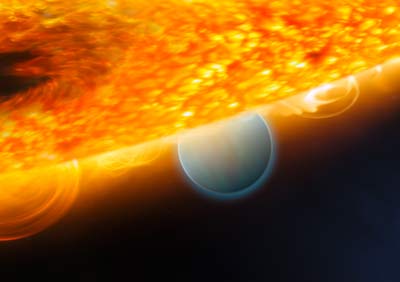Hubble Discovers Carbon Dioxide on an Exoplanet
NASA’s Hubble Space Telescope has made a significant discovery by detecting carbon dioxide in the atmosphere of a planet that orbits a different star. This finding is a crucial step in the search for chemical indicators of extraterrestrial life as we know it.
The planet, named HD 189733b, is similar in size to Jupiter but too hot to support life. However, the observations made by the Hubble telescope serve as a proof-of-concept demonstration that the fundamental chemistry required for life can be measured on planets orbiting other stars. Organic compounds, which can be by-products of life processes, may one day be detected on an Earth-like planet, providing the first evidence of life beyond our own.
Previous observations of HD 189733b using the Hubble and Spitzer Space Telescopes had already identified the presence of water vapor and methane in its atmosphere. Now, with the detection of carbon dioxide, Hubble is enabling scientists to study the conditions, chemistry, and composition of atmospheres on other planets. This marks the beginning of an era where our knowledge of molecules on other planets will rapidly expand, thanks to Hubble’s capabilities.
To study the planet’s atmosphere, Mark Swain of NASA’s Jet Propulsion Laboratory utilized Hubble’s Near Infrared Camera and Multi-Object Spectrometer (NICMOS). By analyzing the infrared light emitted by the planet, located 63 light-years away, Swain was able to identify the presence of carbon dioxide and carbon monoxide. These molecules have their own distinct spectral fingerprints, which can be observed in the radiation emitted by the planet and detected on Earth. This groundbreaking achievement represents the first time a near-infrared emission spectrum has been obtained for an exoplanet.

Swain emphasizes that carbon dioxide is the primary focus of excitement due to its potential connection to biological activity, similar to its role on Earth. The ability to detect and estimate its abundance is significant for the ongoing effort to characterize planets and determine if they could potentially support life.
To conduct this type of observation effectively, planets with orbits tilted edge-on to Earth are ideal. These planets regularly pass in front of and behind their parent stars, resulting in eclipses. For instance, the planet HD 189733b passes behind its companion star every 2.2 days. This presents an opportunity to analyze the planet’s “day-side” atmosphere by subtracting the light emitted solely by the star when the planet is blocked, allowing for a chemical analysis of the planet’s emission.
Swain explains that by utilizing the eclipse of the planet behind the star, he can investigate the hottest regions of the planet’s atmosphere on its day side. This approach enables the identification of molecules and the examination of variations between the day and night sides.
The successful demonstration of observing near-infrared light emitted from a planet is highly promising for astronomers planning to utilize NASA’s James Webb Space Telescope, scheduled for launch in 2013. Near-infrared wavelengths are particularly effective for detecting biomarkers.
Astronomers are eagerly anticipating the utilization of the Webb telescope to conduct spectroscopic examinations in search of biomarkers on a terrestrial planet similar in size to Earth, or a “super-Earth” with a mass several times that of our planet. According to Swain, “The Webb telescope is expected to enable significantly more precise measurements of these primary and secondary eclipse events.”
Swain’s subsequent objective involves investigating the presence of molecules in the atmospheres of other exoplanets, while also striving to enhance the number of molecules detected in exoplanet atmospheres. Additionally, he intends to employ molecules as a means to study potential changes occurring within exoplanet atmospheres, thereby gaining insights into the weather patterns of these remote worlds.
This article is republished from PhysORG under a Creative Commons license. Read the original article.
Do not forget to share your opinion with us to provide you with the best posts !



0 Comments